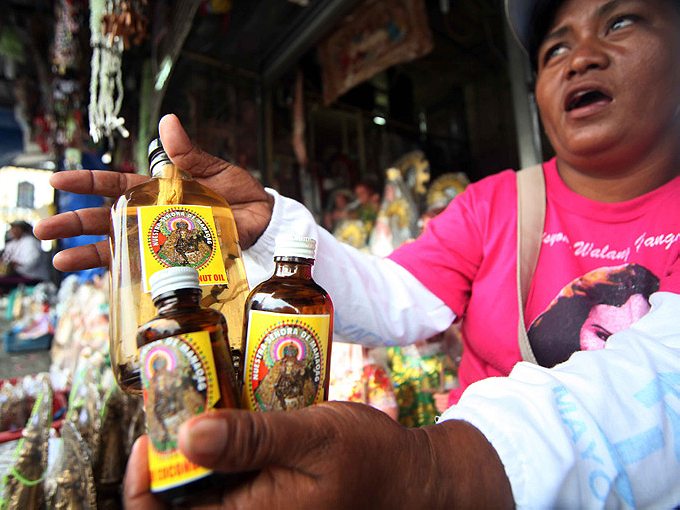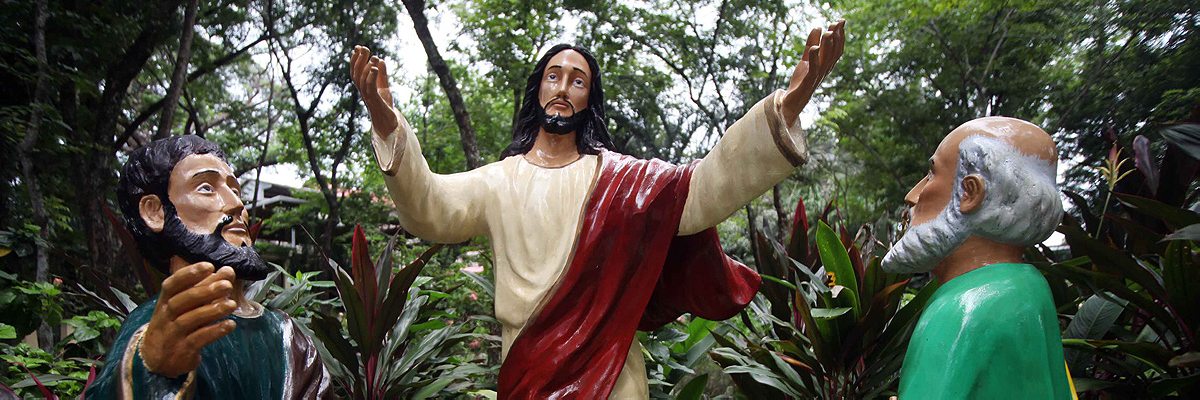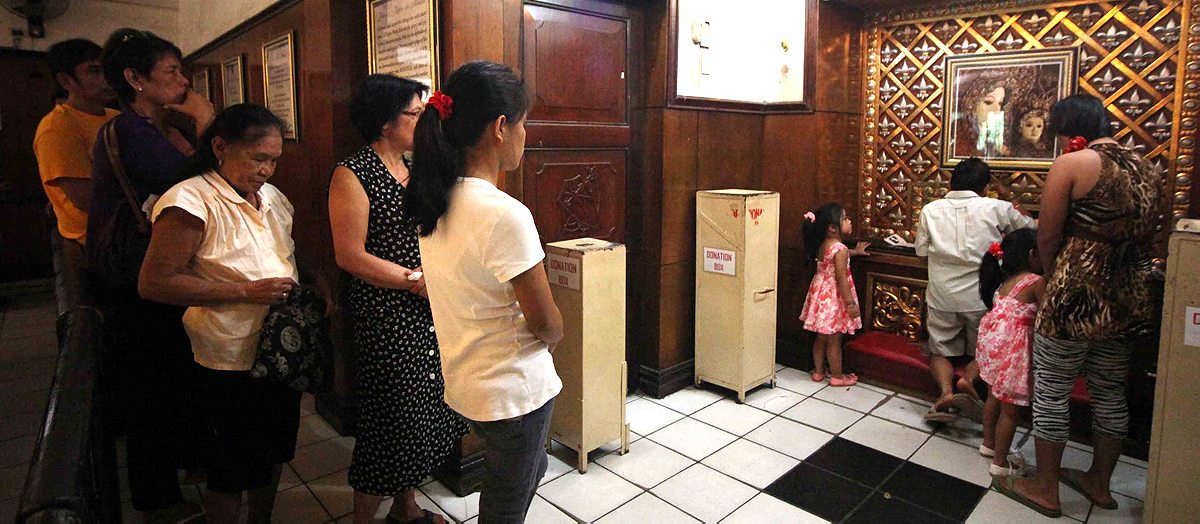Howard Chua-Eoan takes the pilgrimage from Manila to the shrine of Virgin Mary in Manaog.
If you want to touch the Virgin Mary, you must travel about 120 miles north of Manila to the town of Manaoag. It is a route suffused with emblems of the country’s schizophrenic history and culture: Spanish and Asian, Anglo and Latino, Roman Catholic and anti-Catholic, democratic and dictatorial, capitalist and communist, immensely rich and immensely poor. I was in the Philippines for an elaborate and calorie-packed family reunion, and only had one free day in two weeks there, but I decided to use that day to seek out Mary of Manaoag. The demi-basilica dedicated to Our Lady of the Rosary is not easy to reach, but it has become the principal destination of Marian pilgrimage in a nation that is, for the most part, in love with the virgin mother of God.
In the Philippines, Mary’s grottos are everywhere: in the wide tracts of tin-and-scrap slums that stretch out between the city’s glittering developments and skyscrapers, in gardens of the rich and the patches of green of the poor, in roadside stalls, on rocks off the beach. As I settled into my cousin’s work van and hit the road, Mary’s enormous, tarnished gold face emerged from the tangle of shadows and traffic jams along Epifanio de los Santos—a thoroughfare whose name literally and aptly means epiphany of the saints. Metropolitan Manila, the city anointed by Spanish colonial rulers as siempre leal (ever loyal), grew deeper inland from its deep bay to become an unruly amalgam of cities and towns, a megalopolis of some 12 million people, and Mary grew with her. This mega Mary, a huge statue erected in 1989, stands at an intersection on EDSA where the citizens of the ever-loyal city rebelled in February 1986 against the dictator Ferdinand Marcos. At the directive of the Archbishop of Manila, they packed the thoroughfare to protect soldiers who had mutinied against the regime. Marcos sent tanks against the unarmed civilians, priests carrying a statue of Our Lady of Fatima and nuns intoning “Holy Mary Mother of God, pray for us sinners, now and at the hour of our death.” The tanks—and Marcos–never really had a chance.
By coincidence, the day I set off for Manaoag was August 1, the fourth anniversary of the death of Corazon Aquino, who was elevated by that popular uprising to become President of the Philippines and somewhat of an object of veneration herself. Deeply Catholic, Aquino embodied all the virtues that the autocrat did not: guilelessness, loyalty, piety, long-suffering, humility, sorrow, and all the other ingredients that allow indignation to become righteous. Like Mary mourned Jesus, Aquino mourned her murdered husband (who had been assassinated while being taken into custody by the Marcos regime). She was the Madonna of the Philippine Revolution of 1986 and a global saint of democracy. She would gain one more parallel with the Mother of God in time: Aquino became the mother of a president. The depth of mourning at her death from cancer in 2009 helped propel her son Benigno Aquino III to the presidency the next year.
MANY STATUES WERE SAID TO HAVE BEEN FOUND SITTING IN TREES—WHICH WERE CONSIDERED PORTALS TO UNSEEN WORLDS BY PRE-HISPANIC FILIPINOS
The route to Manaoag, over well-paved roads and highways, cuts through the provinces of Bulacan, Pampanga, Tarlac and Pangasinan as well as the Hacienda Luisita, the gigantic sugar cane plantation owned by Corazon Aquino’s family, the Cojuangcos. It also moves through towns named for the titles and descriptions of Mary. There is Angeles, after the Virgin’s title of Queen of Angels; Dolores, for the Lady of Sorrows she became when she mourned her son’s crucifixion; Concepcion, for her own Immaculate Conception, a guiltlessness required for her to become the appropriate vessel to bear the sinless Son of God; Rosales, for her medieval European association with the rose; Carmen, an allusion Our Lady of Mount Carmel; and Victoria, a reference to the famous 15th century statue of the Virgin of Victory of Malaga in Spain.
The 300-year-long Spanish hold over what is now known as the Philippine archipelago—a disparate place with no political affiliation or even common language from island to island—was cemented by the Virgin Mary. Many of the statues now venerated were said to have been found sitting in trees—which were considered sacred or portals to unseen worlds by pre-Hispanic Filipinos—before being moved to more permanent positions in churches. The uniformity of Catholic veneration to her miraculous statues, many imported from Spain, helped link village to village and island to island in a Hispanic liturgical language and piety. The Iberian strain is visible on the road to Manaoag: there is a town called Gerona, after the gorgeous medieval town in Catalonia; and one called Mexico, after the Spanish territory that administered the Philippines for a couple of centuries. There is the town of Urdaneta, named for a Basque explorer; and Legaspi, named for Miguel Lopez de Legazpi, another Basque who consolidated Spanish political rule in 1571. The country itself was named for King Philip II of Spain. Spain would rule the islands until it was defeated in 1898 in the Spanish-American war.

America has a presence on the road as well. There are the billboarded paeans to jeans, soft-drinks, pale complexions and blonde hair. There are the shopping malls everywhere, even in towns far from the big city sprawl. And there’s the prevalence of English as the language of advertising, including one loud proclamation above the road to Manaoag—“You say Dubai. We say Hello,”—that advertises services for migrant workers moving to the Middle East. Indeed, the shopping malls are soaking up much of the $1 billion a month being sent home by overseas Filipinos to their relatives in the islands, money that is almost always spent on consumer goods. It is part of a heart-rending phenomenon: mothers separated from children, sons from parents, all part of a generation sacrificed to earn money overseas to support underemployed or jobless relatives back home.
But on the road to Manaoag there’s more than just consumerism to hint at America’s role in the Philippines. The route takes us onto the MacArthur Highway, named for the U.S. Generalissimo who promised “I shall return” after the U.S. was chased out of the Philippines by the Japanese at the start of the Pacific War (spoiler alert: he did return). Then there are the signs directing travelers to Subic Bay and Clark, the former U.S. military bases that were pivotal to Washington’s strategy in the late Cold War after the Soviet navy leased Cam Ranh Bay from Vietnam. One of Marcos’ secrets to dictatorial longevity was convincing successive U.S. presidents that only he could stand up to communist guerrillas and guarantee the political stability that made the bases viable.
But the least likely reminder of the American period is an extinct volcano: 3,300-foot tall Mount Arayat. It came into view soon after the enormous billboards of Metro Manila give way to rice paddies that seem to stretch as far as the Sierra Madre mountains that mark the eastern horizon. The broad new superhighway called SCTex (short for Subic-Clark-Tarlac Expressway) skirts almost two-thirds around Arayat, allowing the mountain to dominate much of the trip. It was from Arayat that the leftist guerrillas called the Huks harassed the powers-that-be in Manila—and led to the assignment of the legendary CIA operative Edward Lansdale to defuse the rebellion and to prop up the U.S. backed government with the election of a populist president. Lansdale would eventually move on to the U.S. operations in Vietnam. But the Huks’ ideological heirs would continue to beset governments in Manila. And while their armed wings no longer threaten to overthrow the government, they still exist. Sitting in the van, I looked over a local newspaper report on the military killing six insurgents belonging to the New People’s Army near the village of Camiling, Tarlac, just about 16 miles away from one point of the highway.
THE ROAD BORE EVIDENCE OF A THREAT TO ROMAN CATHOLIC DOMINANCE
Filipino Catholics may have welcomed U.S. support against atheistic communism, but the road to Manaoag bore evidence of a threat to Roman Catholic dominance introduced by the very American concept of the separation of Church and State: the rise of non-Catholic Christian denominations. There were several signs for United Methodist churches. But the most distinctive architecture on the road belonged to what is called the Iglesia ni Kristo, a church founded in the early 20th century during the American occupation and which is doctrinally inimical to Roman Catholic theology. The tall spires of the Iglesia dominate small towns in ways that the old church bell towers used to. On an early stretch of the SCTex, I saw the imposing shape of a sports stadium, estimated to seat 55,000 people once completed in 2014. It is the extravagant centennial gift of the Iglesia ni Kristo to itself; and an undeniable declaration of presence and power.
In contrast, the shrine church at Manaoag is practically invisible when we arrive after a four-hour trip. We end up at the parking lot of the church after wending up and down a hill to finally find a gate through the wall of a compound planted with tall trees and surrounded by a virtual moat of souvenir sellers who are prohibited from plying their wares within the sacred precincts (the church has its own gift shops). Not that the precincts themselves appear holy: there is a theme park garden in one corner, featuring slightly larger than life size statues of Mary and her son at various stages of their life. They are all painted with the high-gloss, non-pastel shades that commonly enliven Disney rip-offs in China and Latin America.

When you finally walk through the trees, the church begins to show itself. But the building does not exhibit the kind of antiquity associated with the numinous—the mystery of old stone, the hoariness of the holy. That is because the original structure was damaged and largely destroyed by a fire set by anti-clerical revolutionaries in 1898—during an uprising that uprooted the Spanish government but was scotched by invading and conquering Americans. (The resulting three-year long U.S. war against the so-called Philippine Insurrection was actually the suppression of a native independence movement.) The 400-year old statue of the Virgin that is at the heart of Manaoag’s shrine barely escaped intact.
But she survived, and she is the reason Filipinos of all classes are called to Manaoag. The town’s name means literally “that which calls,” derived from the “tawag” or call (Manaoag is syllabicated and pronounced “ma-na-wag”). The middle-class who can afford to drive are here; as are the poor who wait at bus stations and walk long distances (on their feet or their knees, depending on their vows); and there are the well-to-do, including, I assume, the man I saw wearing the kind of sanitary mask to avoid inhaling the germs of the sweaty masses. He was accompanied by two bodyguards.

They come to cast their eyes on the virgin, high in the center of the reredos, her husband Joseph above her in miniature, angels below her feet, an imposing pastel triangle of baroque haute couture, resplendent this time of year in a gown of pink and gold, the crown over her head a gift of the Vatican and an imprimatur of papal approval, a solar burst emanating from her head, glittering with the promise of succor—or so many believe. There are “black” madonnas in the Philippines—icons carved of wood and unpainted, their complexions more akin to that of most Filipinos. Not Our Lady of the Rosary of Manaoag. Her skin is ivory—in color and in material. Her eyes are huge, her nose, while slightly bulbous, does nothing to detract from the face’s aristocratic, Spanish mien. Her son, whom she holds with a hand to his side and one below his feet, is almost an afterthought, slightly awkward in composition, looking adoringly at his mother, one hand reaching for her chin. But it is not the face and front of Our Lady that the pilgrims come for. It is her back.
You get to her rear by leaving the sanctuary and getting in a queue demarcated by metal railing that lead up to steps. These take you up to a room that both displays and stores the other holy manikins of Manaoag, including Saint Peter (complete with telltale rooster); and Mary Magdalene with the long hair with which she washed the feet of our Lord (who takes up the central displays in two forms, as the resurrected Christ and as the holy child, the Santo Niño.) They stand lit up in glass and wood cases and pilgrims walk up and touch the glass, or tapping on it softly, as if to wake the saint to hear their prayers. But these are supplementary invocations best saved for after they have touched the virgin.

The queue leads the pilgrims to an alcove where, below a close-up photograph of the statue behind the wall, the one in the middle of the altar, a horizontal panel has been cut out, allowing pilgrims crouched on a kneeler (big enough only for two) to reach through and touch the back of the Virgin’s mantle. It’s not an ancient relic, and is replaced often; still, the fabric is a little stiff and ragged from all the touching, the pattern of the elaborate embroidery vanishing in places within reach of the faithful. One man puts his handkerchief in to touch the weblike material of the mantle three or four times after silent prayer, crossing himself each time. Another reaches in to touch the holy clothing and then uses the same hand to cross his heart before reaching back in to touch her again, then making the sign of the cross on an arm. He repeats the process for each limb and his head. It is Thursday and the crowds who pack the shrine to suffocation on Saturdays and Sundays are not here. But there are enough to make the line a long wait, even if there are only six people ahead. Everyone who reaches the kneeler tries to use up all of the recommended one-minute allowance—if not more—to soak up the virgin’s divine radiance, and the microscopic traces of the threads of her trousseau. At moments, it feels almost desperate.
There are cautions everywhere that miracles should not be expected, that it is God who decides what occurs and that a single human being cannot hope to comprehend what the King of Heaven has planned for him or her. And yet, despite this counsel and despite the ivory distance of the baroque virgin’s visage, a sense of intimacy prevails. In a country of nicknames—a practice adopted from the Americans for whom the use of nicknames was proof of easy accessibility, of social closeness—the Virgin Mary has one too. Corazon Aquino became known as Tita Cory—Auntie Cory—after she retired from the Presidency. Her son Benigno III is known as Noynoy (his father was Ninoy). And Our Lady? She is Mama Mary. Lèse-majesté? Not when she has allowed them to touch the back of her dress. And everyone did sacrifice so much to come all the way to Manaoag. I said my prayers for the family feasts to come, touched the gown and jumped back into the van for the four-hour ride back to Manila.